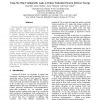Free Online Productivity Tools
i2Speak
i2Symbol
i2OCR
iTex2Img
iWeb2Print
iWeb2Shot
i2Type
iPdf2Split
iPdf2Merge
i2Bopomofo
i2Arabic
i2Style
i2Image
i2PDF
iLatex2Rtf
Sci2ools
FCCM
2002
IEEE
2002
IEEE
Using On-Chip Configurable Logic to Reduce Embedded System Software Energy
We examine the energy savings possible by re-mapping critical software loops from a microprocessor to configurable logic appearing on the same-chip in commodity chips now commercially available. That logic is typically intended to implement peripherals and coprocessors without increasing chip count – but we show that reduced software energy is an additional benefit, making such chips even more useful. We find critical software loops and re-implement them in the configurable logic such that a repeating software task completes sooner, allowing us to put the system in a low-power state for longer periods, thus reducing energy. We use simulations and estimations for a hypothetical device having a 32-bit MIPS processor plus configurable logic, yielding energy savings of 25%, increasing to 39% assuming voltage scaling. We physically measured several examples running on two commercial single-chip devices having an 8-bit 8051 microprocessor plus configurable logic and a 32-bit ARM microproc...
| Added | 14 Jul 2010 |
| Updated | 14 Jul 2010 |
| Type | Conference |
| Year | 2002 |
| Where | FCCM |
| Authors | Greg Stitt, Brian Grattan, Jason R. Villarreal, Frank Vahid |
Comments (0)

